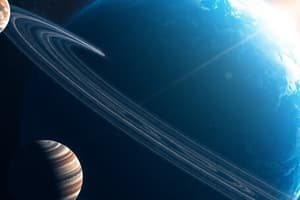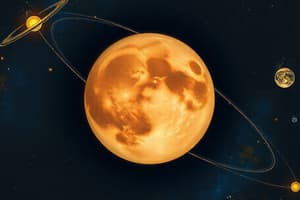Podcast
Questions and Answers
Why does Mercury experience extreme temperature variations between day and night?
Why does Mercury experience extreme temperature variations between day and night?
- Its proximity to the sun results in intense solar radiation during the day.
- Its surface is primarily composed of materials with low thermal conductivity.
- Its slow rotation rate causes prolonged exposure to sunlight and darkness.
- It lacks a substantial atmosphere to trap and distribute heat evenly. (correct)
What evidence suggests the potential presence of water ice on Mercury?
What evidence suggests the potential presence of water ice on Mercury?
- Detection of radar-bright features in permanently shadowed craters at the poles. (correct)
- The presence of hydrated minerals in Mercury's crustal composition.
- Direct observation of surface features resembling frozen lakes.
- Analysis of exospheric gases detected by the MESSENGER probe.
Why is Mariner 10 significant in the exploration of Mercury?
Why is Mariner 10 significant in the exploration of Mercury?
- It was the first spacecraft to perform flybys of Mercury, studying its surface and environment. (correct)
- It was the first spacecraft to orbit Mercury and map its entire surface.
- It confirmed the existence of a magnetic field around Mercury.
- It was the first mission to discover evidence of water ice on Mercury.
What is the primary mission of the BepiColombo mission to Mercury?
What is the primary mission of the BepiColombo mission to Mercury?
Why does Mercury have a relatively short orbital period (year) compared to Earth?
Why does Mercury have a relatively short orbital period (year) compared to Earth?
How do 'crater rays' form on Mercury's surface?
How do 'crater rays' form on Mercury's surface?
What are the primary components of Mercury's internal structure?
What are the primary components of Mercury's internal structure?
Why is Mercury named after the Roman god of travel?
Why is Mercury named after the Roman god of travel?
What was a key objective achieved by the MESSENGER mission to Mercury?
What was a key objective achieved by the MESSENGER mission to Mercury?
What role did Venus play in the Mariner 10 mission's trajectory to Mercury?
What role did Venus play in the Mariner 10 mission's trajectory to Mercury?
Which characteristic distinguishes Mercury from other planets in our solar system?
Which characteristic distinguishes Mercury from other planets in our solar system?
What caused the numerous craters on Mercury's surface?
What caused the numerous craters on Mercury's surface?
Approximately how long does it take Mercury to complete one rotation on its axis?
Approximately how long does it take Mercury to complete one rotation on its axis?
How does Mercury's slow rotation rate affect the length of a solar day on the planet?
How does Mercury's slow rotation rate affect the length of a solar day on the planet?
What is the primary scientific objective of ESA's Mercury Planetary Orbiter (MPO)?
What is the primary scientific objective of ESA's Mercury Planetary Orbiter (MPO)?
How does the proximity of a planet to the sun typically affect its orbital speed?
How does the proximity of a planet to the sun typically affect its orbital speed?
Why might water ice be preserved in craters near Mercury's poles despite the planet's high temperatures?
Why might water ice be preserved in craters near Mercury's poles despite the planet's high temperatures?
Before the BepiColombo mission, which spacecraft had previously visited Mercury?
Before the BepiColombo mission, which spacecraft had previously visited Mercury?
What is the estimated age of Mercury, based on its formation alongside the rest of the solar system?
What is the estimated age of Mercury, based on its formation alongside the rest of the solar system?
Which of the following is NOT a feature of Mercury?
Which of the following is NOT a feature of Mercury?
Flashcards
Mercury's Formation
Mercury's Formation
Formed 4.5 billion years ago from swirling gas and dust, Mercury is the closest planet to the Sun with a central core, rocky mantle, and solid crust.
Mercury's namesake
Mercury's namesake
Mercury is named after the Roman God of travel, also known as Hermes in Greek mythology.
Mercury's Size and Position
Mercury's Size and Position
Smallest planet in our solar system, a little bigger than Earth's Moon, and the closest planet to the Sun.
Mercury's Surface
Mercury's Surface
Signup and view all the flashcards
Surface Appearance
Surface Appearance
Signup and view all the flashcards
Temperature Extremes
Temperature Extremes
Signup and view all the flashcards
Water Ice on Mercury
Water Ice on Mercury
Signup and view all the flashcards
Orbital Speed
Orbital Speed
Signup and view all the flashcards
Rotation and Year Length
Rotation and Year Length
Signup and view all the flashcards
Mariner 10 Mission
Mariner 10 Mission
Signup and view all the flashcards
MESSENGER Mission
MESSENGER Mission
Signup and view all the flashcards
BepiColombo Mission
BepiColombo Mission
Signup and view all the flashcards
Study Notes
- Mercury formed roughly 4.5 billion years ago due to gravity-driven gas and dust swirling.
- Mercury is nearest the Sun.
- Mercury has a central core, a rocky mantle, and a solid crust, similar to other terrestrial planets.
- Mercury is named after the Roman god of travel and is also called Hermes, the Greek god messenger.
- Hermes is depicted with winged shoes, symbolizing fast movement, like the planet Mercury.
- Mercury is the smallest planet in the solar system, being slightly larger than Earth's Moon.
- Despite being closest to the Sun, Mercury is not the hottest planet as Venus is hotter.
- Mercury features a solid surface filled with craters like Earth’s Moon, made by impacts from meteoroids, comets and asteroids.
- The surface of Mercury is mainly greyish-brown, featuring bright streaks known as "crater rays".
- Crater rays form following an asteroid or comet impact.
- Temperatures on Mercury's surface vary widely, with daytime temperatures reaching 800 degrees Fahrenheit (430 degrees Celsius).
- The lack of an atmosphere causes nighttime temperatures to plummet to minus 290 degrees Fahrenheit (minus 180 degrees Celsius).
- Water ice may exist in permanently shadowed deep craters at Mercury's north and south poles.
- Mercury is the fastest planet, traveling at nearly 29 miles (47 kilometers) per second.
- Mercury has the shortest year of any planet at 88 Earth days.
- Mercury rotates slowly, with one rotation taking 59 Earth days, but an orbit takes only 88 Earth days.
Exploration of Mercury
- Two NASA missions have explored Mercury.
- Mariner 10 was the first spacecraft to fly by Mercury, also using Venus' gravity to adjust its speed and trajectory in the process.
- MESSENGER was the first spacecraft to orbit Mercury
- MESSENGER discovered significant water amounts in Mercury's exosphere.
- The MESSENGER spacecraft orbited Mercury for over four years.
- The MESSENGER mission determined Mercury's surface composition, revealed its geological history, detailed its internal magnetic field, and verified water-ice in its polar deposits.
- The MESSENGER mission concluded when it intentionally crashed into Mercury’s surface.
- The ESA and JAXA launched the BepiColombo mission in 2018, comprised of two spacecraft which include the ESA-built Mercury Planetary Orbiter and JAXA-supplied Mercury Magnetospheric Orbiter.
- BepiColombo is scheduled to orbit Mercury by 2025.
- The Mercury Planetary Orbiter (MPO) will investigate Mercury's surface and interior.
- The Mercury Magnetospheric Orbiter (MIO) will study Mercury's magnetic field.
- BepiColombo represents the first Mercury missions for the ESA and Japan.
Studying That Suits You
Use AI to generate personalized quizzes and flashcards to suit your learning preferences.




